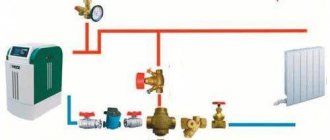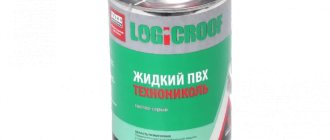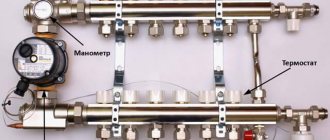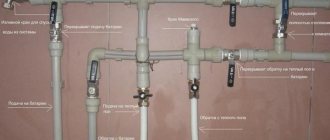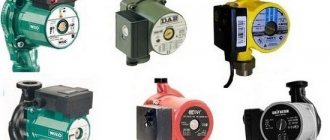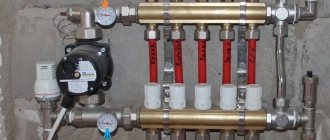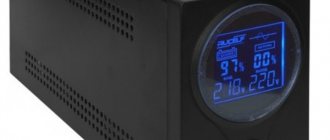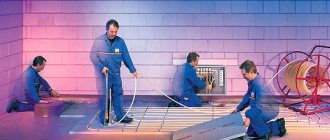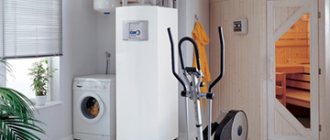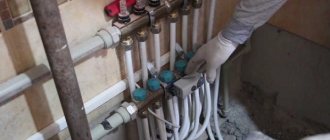Practical recommendations for the maintenance and operation of circulation pumps
Circulation pump
In order to extend the operating time of the circulation pump, you need to follow several rules.
1. The body of modern pumps is made of fragile stainless alloys, and not of cast iron, as was previously done. Do not tighten the connecting elements with great force, do not use tow for sealing. To avoid leaks, it is strongly recommended to use only modern tapes. They hold water pressure perfectly, and to completely seal the connections there is no need to tighten the nuts too much.
2. The pump must be located in such a place that, if necessary, repair work or routine maintenance can be carried out without problems. Foreign manufacturers produce very high-quality pumps, but taking into account domestic operating conditions and the chemical composition of water, it is recommended to check their technical condition before each heating season
Particular attention should be paid to the integrity of the oil seal to waterproof the pump shaft from the rotor. If the water contains a lot of dissolved calcium, then over time hard deposits form on metal surfaces, damaging the seal.
They must be carefully removed.
3
Before starting the underfloor heating system for the first time, it is important to completely remove all air pockets. To do this, you will have to change the water in the system several times and, if necessary, install a special valve
The presence of air pockets creates obstacles to the movement of coolants, the floor heating temperature is lower than the set one. The automation constantly turns on the pump, as a result its operating time increases significantly, and the warranty service life is exhausted prematurely.
If all installation work is carried out in accordance with the recommendations, the power and performance indicators of the pump are selected correctly, technical routine work is carried out in a timely manner and in full, that is, a guarantee of the effective functioning of the floor heating system.
Pump operating rules
In order for the Grundfos pump for heated floors to last as long as possible, a number of rules must be followed during its operation and maintenance:
- Modern pumps, unlike their older counterparts, are made from various alloys that are not very durable. This suggests that you cannot tighten the connections too much, as well as seal them with tow. In order for the system to be airtight, when connecting the pump you need to use modern tapes - they can withstand any pressure perfectly and allow you to do without over-tightening the nuts.
- You need to choose a place to install the pump so that, if necessary, it can be easily accessed. Of course, modern pumps from leading manufacturers can operate without maintenance for quite a long time, but the need for preventive maintenance has not been canceled - and this is why you need to install the pump in an easily accessible place. During regular maintenance, you should first of all pay attention to the condition of the oil seal - if the water contains a lot of impurities, they gradually harden and begin to damage it. Solid deposits are removed manually (to reduce their amount, install an appropriate filter in front of the pump inlet).
- Before starting the heated floor, you need to make sure that there are no air pockets in the system. The presence of air in the circuit complicates the circulation of the coolant, because of this the floor remains cold, and properly working automation signals the pump about the need for emergency activation. The result is obvious: the pump starts up much more often than usual, and its service life gradually decreases, which leads to the need for premature replacement.
Connection to an individual heating boiler
The presence of an individual heating boiler in an apartment or private house eliminates all organizational problems in permitting the installation of water heated floors. In this case, connecting a warm water floor does not require any permits. Depending on the location and operation conditions of the facility, boilers can be of various types:
- on gas fuel;
- on liquid fuel (diesel, fuel oil);
- solid fuel: firewood, pellets, coal;
- electrical;
- combined.
In apartments in multi-storey buildings, gas or electric heating boilers are most often used; connecting a heated floor circuit to the central heating system is not required. In this case, the diagram differs slightly, but the functional purpose of the main elements remains the same.
Diagram of a water heated floor system in a private house with an autonomous boiler
Essential elements:
- boiler;
- expansion tank;
- pressure gauge;
- circulation pump;
- manifold for underfloor heating;
Unlike the case with central heating, connecting a heated floor to a boiler does not require installing a three-way valve to regulate the temperature of the coolant. Its installation is not necessary; the temperature can be changed from the boiler control panel. Temperature control sensors are also located on the external control panel.
The expansion tank serves to maintain stable pressure in the system; when heated, the volume of liquid increases. To prevent the underfloor heating collector, pump and other expensive elements in the pipeline system from collapsing, the tank compensates for the expansion of the coolant volume. The pressure gauge shows the pressure in the pipes. The main thing is that before pouring the solution into a warm floor, you need to check the functionality of all components.
Control panel on the boiler body
Regardless of the modification of the device and its manufacturer, all panels have basic options, and some additional programming functions:
- buttons or regulators for increasing and decreasing the supply coolant temperature;
- button for automatically setting a comfortable, economical temperature mode, room temperature – 20-22 ̊C;
- It is possible to program control, set the modes “winter”, “summer”, “vacation”, “function of protecting the system from freezing of liquid”.
How to make specific settings for boilers with different control panels is described in the operating instructions. Filling a water heated floor with a solution for a separate boiler is done in the same way as for central heating.
Remote control panel
Methods for connecting an additional device: how to install it?
Often additional pumps are installed in the heating or water supply system. There are several reasons for such modernization.
For example, if there is not enough pressure for normal operation of the washing machine, or when installing a heated towel rail, heated floor, or connecting an additional circuit.
The rules and methods for installing an additional device are the same as for the main one. The additional highway is simply regarded as a separate system.
Sometimes such modernization is carried out to strengthen the system in the dead of winter, during severe cold weather. In this case, the drive is connected to a thermal relay-thermostat. Accordingly, when the coolant temperature drops in a given area, additional circulation is turned on, increasing the coolant current.
Reference! Pumps are installed in the water supply system for approximately the same purposes. But only in this case is a system with a timer preferable, since amplification will be required only during peak analysis hours: in the morning and in the evening. The rest of the time, the standard system is sufficient.
The electrical part is easy to connect. According to the marking of the contact group: zero, phase, ground.
How not to install a circulation pump in heating
It was said above that the efficiency of the equipment depends on the correct installation of the circulation pump in the heating system. Let's look at the main mistakes when installing a circulation pump, which will help to avoid them in the future.
For return or delivery? Considering the fairly large temperature difference between the return and supply heating lines, it is better to install the pump on the return line. In this case, the pump will overheat less and will not boil when critical temperatures occur.
Dirt filter. A prerequisite for the normal functioning of the circulation pump is the presence of a coarse filter (with a metal mesh inside). Otherwise, the pump may quickly become clogged and fail. Also, in order to be able to repair or replace the existing circulation pump, two taps must be installed for quick replacement.
In what area should I place it? The heating pump can be installed on almost any section of the pipeline: vertical, horizontal and even inclined. The only point that will need to be taken into account is that the rotor of the circulation pump is only in the horizontal plane. In simple words, the pump cannot be installed with the rotor up and down.
How to set it correctly? When installing, the box on the pump with terminals should be at the top or, in extreme cases, on the side. It is not allowed to install the circulation pump in such a way that the plastic box is located at the bottom. Otherwise, a short circuit may occur, which will result in pump failure.
Where should the arrow on the pump point? And, of course, when installing the pump, you need to take into account the direction of coolant flow in the heating system. If the pump is installed on the return line, then its arrow should point towards the heating boiler. If on the contrary, then, accordingly, the arrow should be directed in the other direction.
Proper installation of a circulation pump in a heating system will help avoid a number of problems associated with the operation of expensive equipment.
Where to install the pump for the supply or return of a heated floor
Home / House construction / Floor / Where to install the pump for the supply or return of a heated floor
Today there is a lot of information on the Internet about circulation pumps and their installation. And yet this question is relevant, because due to their specialty, many users find it difficult to understand and understand this system. In this article we will figure out where it is better to install the pump - on the supply or return.
You can often find information on the Internet that it is better to install the pump on the return line, and of course, there are certain explanations for this:
- If you put the pump on the supply, the pump will fail faster, because the temperature is higher here, but if you put it on the return, the unit will last for many years;
- At supply, the density of water is less and it is difficult to pump;
- The return pressure is higher, and therefore the pump is easier to work with.
But all the above arguments are considered not entirely correct and we will figure out why.
- Firstly, the permissible temperature for pumps is +110 - +115 degrees, but in a heating system, the temperature usually reaches 80 o and in rare cases 90 o. Therefore, the moment where to install the pump on the return or supply has no influence.
- The density of water also does not affect, because the difference between this parameter at a temperature of 50 o and 80 o is so small that it will not affect the operation of the unit in any way.
- The pressure difference between the value in the coolant and the main line is also very small, which makes no sense to calculate it.
Based on this, we draw the only conclusion that circulation pumps can be installed both on the supply and return side. And where it will be installed will not affect its operation and durability in any way. The main condition that must be met when installing a boiler is ease of maintenance.
When installing the pump, the main thing is to do everything correctly. It is important that the rotor is horizontal. Today, modern pumps are produced with a wet rotor, through which the surfaces that rub are washed. The terminal box that is installed on the rotor should be located on the top or side. It is not permissible to place it at the bottom because it will not be convenient to service it, and in case of a breakthrough it may flood. As we found out earlier, it doesn’t matter at all whether there is a pump on the supply or return . Something completely different is important, namely the pump should be located between the boiler and radiators. It can be in front of the radiators or after them, and the flows will be exactly the same. Under no circumstances should the pump be placed in the middle of the system, because low pressure flows will form.
This is all general information, but what to do if you have a solid fuel boiler.
If such a unit overheats, then it cannot be extinguished instantly, since it is not possible to make the wood burn faster. If the pump in this system is mounted on the supply side, then when the boiler boils, steam is formed, which enters the pump with an impeller and the following occurs:
- The pump is not designed for pumping gases, so the device stops working and the flow speed drops.
- Not enough cooled liquid begins to flow into the boiler tank, so overheating occurs, and the amount of steam increases rapidly.
- When a large amount of steam enters the impeller, the movement in the system stops. This situation is emergency; a safety valve is activated, which releases steam directly into the room.
- If the firewood is not extinguished in this case, then it is possible that the valve will not be able to cope with the pressure and an explosion will occur.
If the pump is installed on the return line, then:
- Under no circumstances will he meet couples;
- And even if steam enters the system, it is pushed into the radiator, where it turns back into liquid.
Moreover, the difference in a possible explosion in both cases is 25 minutes, this time is quite enough to go to the boiler, put out the firewood there and prevent an explosion.
Therefore, in solid fuel boilers, especially those in which there is little or no automation, it is necessary to install the pump on the return line. Moreover, it is correct that it be installed in the following sequence: tap - sump tank - pump - tap. If the system is hybrid, it may well work by gravity, but when this does not work, a pump is installed. It is important to install a tap in this branching system. But the most common mistake that everyone makes is installing a check valve. Under no circumstances should it be installed, because it will stop gravity flow. The tap can be opened when the system operates by gravity and closed when the pump is turned on.
It is very important to treat the heating system with special care, because not only the warmth in the house, but its safety depends on it. Therefore, when installing it yourself, be sure to follow the instructions without any deviations. Well, if you doubt your capabilities, then it is better to turn to professionals who will do everything correctly and competently.
Hydraulic resistance is understood as the sum of the “ring” resistances, i.e. resistance along the length of the pipe + “local” resistances - turns, bends, fittings...
Water is an “incompressible substance” ... this is ... true, but this does not mean at all that ... if the door does not open, then no one is breaking into it ... And if we do not see “compressed” and “swollen” water, this does not mean , that ... there is no pressure or even vacuum inside the water (during “suction”)
Following the request for the “ordinary Kazakh” language... Opening a bottle of sparkling water, which “sprinkles”, releasing pressure, we observe bubbles appearing in the water from nowhere. This carbon dioxide, pumped into water under pressure, turns back into bubbles as soon as the pressure drops... The same process is possible in CO, in the “rarefaction zone”, aggravated by temperature (it is easier for bubbles to form) on the pump, boiler, and in some other places, if you deviate too much from the “general line”. Which sometimes gives rise to “unsolvable” problems with air in the system. heating.
Pump parameters
In addition to having additional functions and type, the pumps differ in their initial parameters. Namely, productivity and pressure. Since water will need to be supplied to the system, the performance will be equal to dividing the power of the heating circuit, multiplied by 0.86 and the difference between the supply temperature and the return coolant temperature. This difference, as practice shows, is 50.
If there are several circuits in the system, it is necessary to determine the performance of each of them and summarize the results obtained among themselves.
The created pressure depends on the hydraulic resistance of the pipe, its length and the power reserve factor. To calculate the pressure, it is necessary to add the product of the hydraulic resistance of one meter of pipe by its length with the power reserve factor and divide everything by 1000. The pressure is necessary for normal coolant circulation in the system.
A parameter such as power depends on the quadrature. There are tables corresponding to the heated area and the required pump power. When calculating them, it is assumed that the house is normally insulated and is not located much north or south of the middle zone. Experts recommend adding about 20% to this parameter in case of severe frosts.
Purpose
To decide whether installation of a pump is required for a fully functioning system, let’s consider the positive and negative aspects of this solution.
The positive arguments are:
- After connecting the circulation pump to the heating system, its inertia will significantly decrease. Thanks to this, the rate of heating of the system from the moment the boiler is ignited until optimal performance is achieved will significantly increase. The forced-injected coolant will begin to warm up the house within a few minutes.
- The temperature readings of devices located at different points in the system will be equalized. Increasing the speed of movement of the coolant will not allow it to quickly cool down in the interval between supply and return, so that pipes in distant points of the house will also be warm.
- If there are sections of pipes with a slope in the direction opposite to the coolant flow, air pockets may form in the system. Connecting the pump to the heating boiler will increase the pressure drop in the circuit so that the coolant can circulate freely, regardless of the presence of air pockets.
Among the disadvantages of installing a circulation pump are the following factors:
- Fixed electricity costs - for successful use it is necessary to connect the circulation pump to the mains. Although its power at maximum values does not exceed 100 watts, the losses will still be constant.
- The forced circulation of the coolant provided for by the project, if it is the only option, makes the system vulnerable in the event of a power outage. If the movement of liquid along the circuit stops, the boiler may overheat the coolant and damage the pipes, and when the heating is turned off, they may freeze.
Thus, in order to ensure that the heating system can operate under any conditions, at the time of its design it is necessary to provide for both natural circulation and the use of a circulation pump.
How to install a pump on a heated floor
Once the location has been chosen, installation should begin. The algorithm of actions is as follows:
- First, a bypass - a bypass pipe - is installed in the location to be mounted.
- To do this, you need to cut the main pipe.
- Form a thread at its ends.
- Install the ball valve and install the pump.
- Open the tap for water access.
- Open the air bleed screw.
- After installing the circulation pump on a heated floor, you must test the system. First, the work is checked at low speed.
Scheme of correct installation of a pump for a heated floor
Why do you need a pump?
A special feature of a water floor is that the length of the pipe can exceed 1 m with a maximum diameter of 2 cm. There are several such circuits in the system. Turns and turns, of which there are quite a lot in the system, make it difficult to circulate fluid. Good circulation can only be ensured by equipping the water heated floor system with a pump.
Let's take a closer look at how to choose the right pump, and what points you should pay special attention to
Manufacturers offer a variety of models. They differ in functionality and, naturally, pricing policy. Don't settle for budget options. They do not have additional features and, as a rule, are not durable.
It is advisable that the pump for a heated floor have a speed switching function. The best option is a three-speed pump. This will allow the system to maintain the desired temperature. Water is supplied to the system at a certain speed. Naturally, movement through the system occurs at the same speed.
When the room temperature drops, the coolant will give off more heat and, therefore, cool faster. And the temperature of the liquid in the pipes will decrease. To prevent this from happening, you need to increase the rate of coolant supply to the system. This type of device can be controlled manually.
If you want to do everything in such a way that the system functions independently, then you can automate the mechanism. Today we have everything we need for this.
As for the type of equipment, it is better to purchase a circulation pump for a water floor. Such a device supplies liquid to the system at a given speed. In this case, excess pressure does not form.
There are pumps with wet and dry rotor. The first ones are not very powerful. Therefore, they are not suitable for a large room. The maximum area they can handle is 400 sq.m. The advantages of this type of equipment include low energy consumption and reliability. It should also be noted that glandless pumps operate very quietly.
If the area of the room exceeds 400 sq. m., then the system must be equipped with a pump with a dry rotor. During operation of such a unit, it is necessary to systematically carry out maintenance. Namely, clean and lubricate.
Another point that you should pay attention to when choosing a device is the presence of an outlet valve. If the underfloor heating system is equipped with air bleed valves, then the presence of a valve is not necessary
If not, then the air trapped in the pipes will interfere with the circulation of water.
Pumps differ not only in their characteristics, type and functional features, but also in appearance. Manufacturers offer pumps whose casings are made of cast iron, stainless steel or polymer material. If the system is completely sealed, then by and large you can choose any option. If there are doubts about tightness, then the cast iron option will not work. When exposed to air, the metal will begin to oxidize, which will lead to unit malfunction.
Particular attention should be paid to the markings of the device and its dimensions. Pump markings require two numbers written as a fraction
The first indicates the diameter of the inlet or outlet holes. Values are indicated in millimeters. The second number indicates the lift height. The marking contains one more number, written with a hyphen from the first two. It indicates the installation length.
And, of course, it’s worth talking about manufacturers. European companies have proven themselves best. There is no need to skimp on equipment. It is the pump that can be called the “heart” of the system. Therefore, it makes sense to purchase equipment from German manufacturers.
Which floor heating pump to choose
Correctly calculating the parameters is not everything. You need to choose the type of pump, the material from which it is made and the manufacturer. This is no less important than the correct characteristics.
Two types of equipment are suitable for domestic use:
- Glandless rotor pumps. These devices are not the most powerful, but in most cases their performance is sufficient to ensure the operation of a heated floor with an area of up to 400 m2. The rotor is called “wet” because the impeller is located directly in the coolant, respectively, cooling and lubrication occur with its use. This equipment is popular because it operates quietly, consumes little electricity and is highly reliable.
Structure of a wet rotor pump - Units with a dry rotor are characterized by increased power. In this case, the rotor is located in a separate sealed container. It requires periodic maintenance - cleaning and lubrication. But such equipment in private households can be used, perhaps, only for constructing fountains.
Dry rotor pumps have increased power and corresponding dimensions
The choice of type is simple: install a unit with a wet rotor. The parameters were calculated. But there are also such subtleties as markings and size (length) of the pump.
Look at the video to see how a pump with a wet rotor looks in real life and how “loud” it works.
